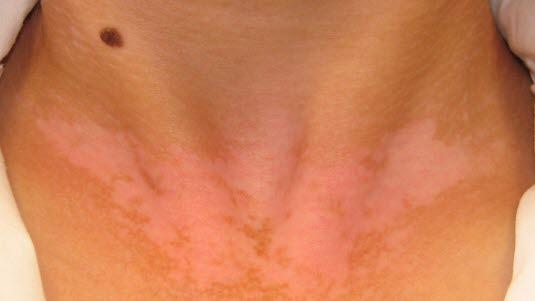Informasjon
Vitiligo (bildet): Tilstanden rammer omtrent en til to prosent av befolkningen.
Hvite flekker på huden, vitiligo
Vitiligo er en tilstand med pigmentfrie, hvite, flekker i huden. Det finnes ingen god behandling mot tilstanden. Behandlingen som kan brukes, er langvarig, og resultatene usikre.

Sist oppdatert:
13. mars 2019
Hva er vitiligo?
Annonse
Vi regner med at én til to prosent av befolkningen har vitiligo, det vil si cirka 50.000 personer i Norge. Tilstanden er like hyppig blant kvinner som menn. Vanligste debutalder er 10-30 år, men tilstanden kan debutere i alle aldersgrupper. Hos omtrent 30 prosent finnes familiær opphopning av tilfeller.
Vil du vite mer
Dette dokumentet er basert på det profesjonelle dokumentet Vitiligo . Referanselisten for dette dokumentet vises nedenfor
Referanser
- Sitek JC. Vitiligo - tap av pigment i huden. Tidsskr Nor Lægeforen 2006; 126: 2370-2. PubMed
- Roncone K. Vitiligo. Medscape, last updated Aug 10, 2018.
- Huang CL, Nordlund JJ, Boissy R. Vitiligo: a manifestation of apoptosis? Am J Clin Dermatol 2002; 3: 301-8. PubMed
- Njoo MD, Westerhof W. Vitiligo. Pathogenesis and treatment. Am J Clin Dermatol 2001; 2: 167-81. PubMed
- Schallreuter KU, Bahadoran P, Picardo M, et al. Vitiligo pathogenesis: autoimmune disease, genetic defect, excessive reactive oxygen species, calcium imbalance, or what else?. Exp Dermatol. 2008 Feb. 17(2):139-40; discussion 141-60.
- Passerou T, Ortonne JP. Physiopathology and genetics of vitiligo. J Autoimmunology 2005; 25: 63-8. PubMed
- Majumder PP, Nordlund JJ, Nath SK. Pattern of familial aggregation of vitiligo. Arch Dermatol 1993; 129: 994. PubMed
- Harris JE, Rashighi M. Vitiligo. BMJ Best Practice, last updated July 2018.
- Whitton ME, Pinart M, Batchelor J, et al. Interventions for vitiligo. Cochrane Database Syst Rev. 2015 Feb 24;2:CD003263. The Cochrane Library
- Taieb A, Alomar A, Böhm M, et al; Vitiligo European Task Force (VETF); European Academy of Dermatology and Venereology (EADV); Union Européenne des Médecins Spécialistes (UEMS). Guidelines for the management of vitiligo: the European Dermatology Forum consensus. Br J Dermatol. 2013;168:5-19. PubMed
- Gargoom AM, Duweb GA, Elzorghany AH, Benghazil M, Bugrein O. Calcipotriol in the treatment of childhood vitiligo. Ped Dermatol 2004; 21: 495-8. PubMed
- Travis LB, Silverberg NB. Calcipotriene and corticosteroid combination therapy for vitiligo. Pediatr Dermatol 2004; 21 (4): 495-8.
- Boone B, Ongenae K, Van Geel N, et al. Topical pimecrolimus in the treatment of vitiligo. Eur J Dermatol. 2007;17:55-61. PubMed
- Silverberg NB, Lin P, Travis L et al. Tacrolimus ointment promotes repigmentation of vitiligo in children: A review of 57 cases. J Am Acad Dermatol 2004; 51: 760-6. PubMed
- Lee JH, Kwon HS, Jung HM et al. Treatment Outcomes of Topical Calcineurin Inhibitor Therapy for Patients With Vitiligo: A Systematic Review and Meta-analysis. JAMA Dermatol 2019. pmid:31141108 PubMed
- Esfandiarpour I, Ekhlasi A, Farajzadeh S, Shamsadini S. The efficacy of pimecrolimus 1% cream plus narrow-band ultraviolet B in the treatment of vitiligo: a double-blind, placebo-controlled clinical trial. J Dermatolog Treat. 2009. 20(1):14-8.
- Njoo MD, Bos JD, Westerhof W. Treatment of generalized vitiligo in children with narrow-band (TL-01) UVB radiation therapy. J AM Acad Dermatol 2000; 42: 245-53. PubMed
- Natta R, Somsak T, Wisuttida T, Laor L. Narrowband ultraviolet b radiation therapy for recalcitrant vitiligo in Asians. J Am Acad Dermatol 2003; 49: 473-6. PubMed
- Stern RS, Lange R. Nonmelanoma skin cancer occurring in patients treated with PUVA five to ten years after first treatment. J Invest Dermatol 1988; 91: 120-4. PubMed
- Hamzavi I, Jain H, McLean D et al. Parametric modelling of narrowband UVB phototherapy for vitiligo using a novel quantitative tool: the vitiligo area scoring index. Arch Dermatol 2004; 140: 677-83. PubMed
- Olsson MJ, Juhlin L. Long-term follow-up of leucoderma patients treated with transplants of autologous cultured melanocytes, ultrathin epidermal sheets and basal cell layer suspension. Br J Dermatol 2002; 147: 893-904. PubMed
- Razmi TM, Kumar R, Rani Sc, et al. Combination of Follicular and Epidermal Cell Suspension as a Novel Surgical Approach in Difficult-to-Treat Vitiligo: A Randomized Clinical Trial. JAMA Dermatol 2018. pmid:29387874 PubMed